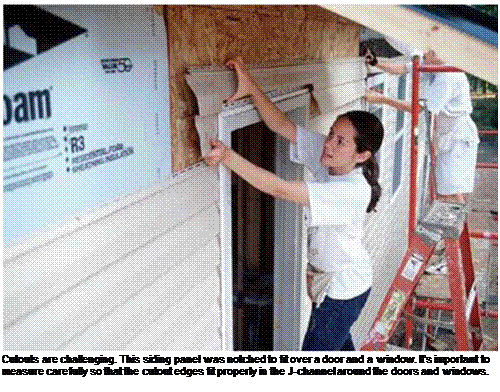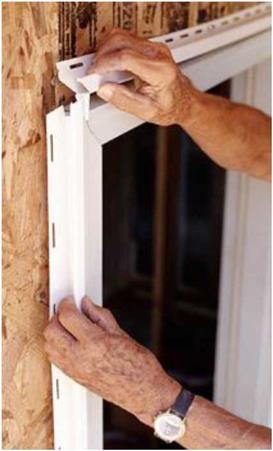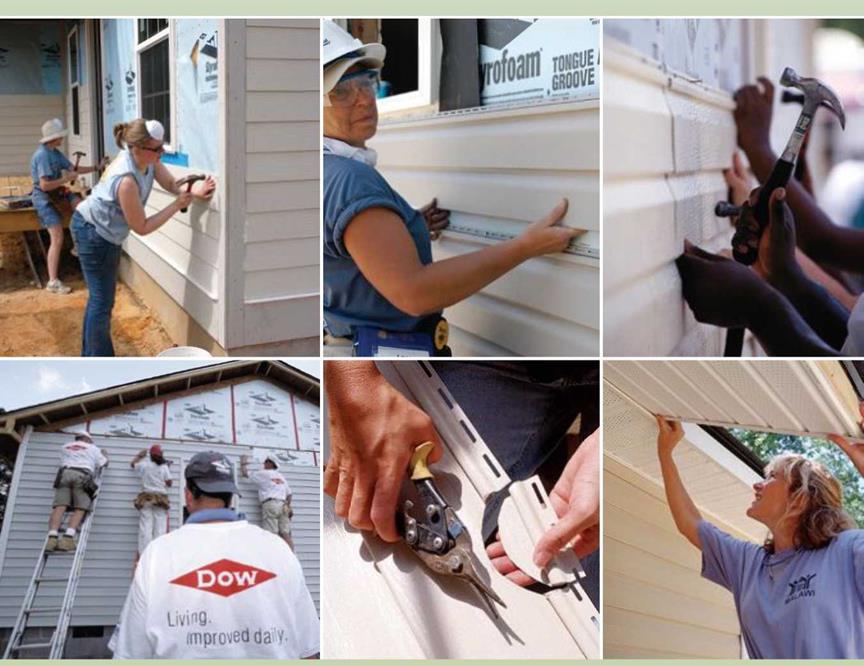STEP 6 INSTALL THE SIDING PANELS
Thanks to the work you did in the previous step, panel installation can go quickly, especially when you have a good-size crew, as we did on this job. The first panel course is always the bottom-most course. Start against the corner on one side of the house (preferably the back corner). Pull up the first panel, snap it into the starter strip, and slide the end of the panel under the corner trim’s top edge. Keep the panel seated in the starter strip as you drive nails into each stud. The nail heads should be Мб in. proud of the flange. Don’t drive nails at the edge of a slot or through the vinyl itself. If the prepunched slot is not centered over a stud, lengthen the slot with a utility knife or a slot-punch tool.
Some volunteers prefer contrast between the white corner trim and the brown siding, whereas others aren’t sure whether it looks attractive.
We install siding panels from the bottom up.
Each new course of panels snaps onto the one below.
You can’t drive the nails hard against the vinyl because it needs to move.
With snips and utility knives, we measure, trim, and cut to fit around windows, doors, outlets, and vents.
The vinyl soffit panels are filled with small holes so that air can pass into the attic space.
They finish off the eaves nicely.
|


encourages the panel to expand and contract equally in both directions.
The clearance between the end of a panel and the inside edges of the trim pieces depends on the temperature. If it’s over 90°F when you install the siding, leave the panel end about 14 in. away from the trim piece’s inside edge. If it’s less than 30°F, leave a good Vi in. of clearance at each end so there’s room for heat-induced expansion. For temperatures between these two extremes, gauge accordingly.
When you come to an opening or reach the end of a wall, cut a panel to fit. Remember always to leave room for expansion. Cut panels to length with a tablesaw, as described earlier using a circular saw with the blade in backward. You can also crosscut with a radial-arm saw, a sliding compound-miter saw, a utility knife, a hacksaw, or even tinsnips. Plan each siding cut so that the cut ends are hidden in the corner posts, in the J-channel trim, or by the factory edge of an overlapping panel. Panels that join within a course should overlap by at least 1 in.
You’ll notice that the nailing flange on a siding panel is cut back about 1 in. from the end of the panel. When two panels join each other in the same course, their nailing flanges should never butt together on the wall. When necessary, cut back the nailing flanges so that those in the same course are separated by at least 1 in.
It’s best to lap the panels between—not on— the studs. Try not to install pieces shorter than 3 ft. long, especially in high-wind areas. And don’t let the overlaps where siding panels meet stack over one another in subsequent courses. Rather, randomly separate these overlaps by two or three studs, so that you don’t create a staircase pattern. The pattern created by the installed vinyl panels should be pleasing to the eye.
Pull each panel up snugly against the locking hem of the previous panel, but don’t stretch it. Panels that were stretched tightly when they
were installed (especially in warm weather) can tear when cold weather causes them to contract. Before moving on to the next row, make sure each panel is free to move back and forth horizontally.
As you proceed upward, measure down from the underside of the trusses to each row to ensure that the siding is remaining level around the building. Vinyl siding can stretch upward and easily become out of level. Some builders snap level chalklines every 2 ft. or so around the building to serve as reference points while they install rows of siding.










Leave a reply